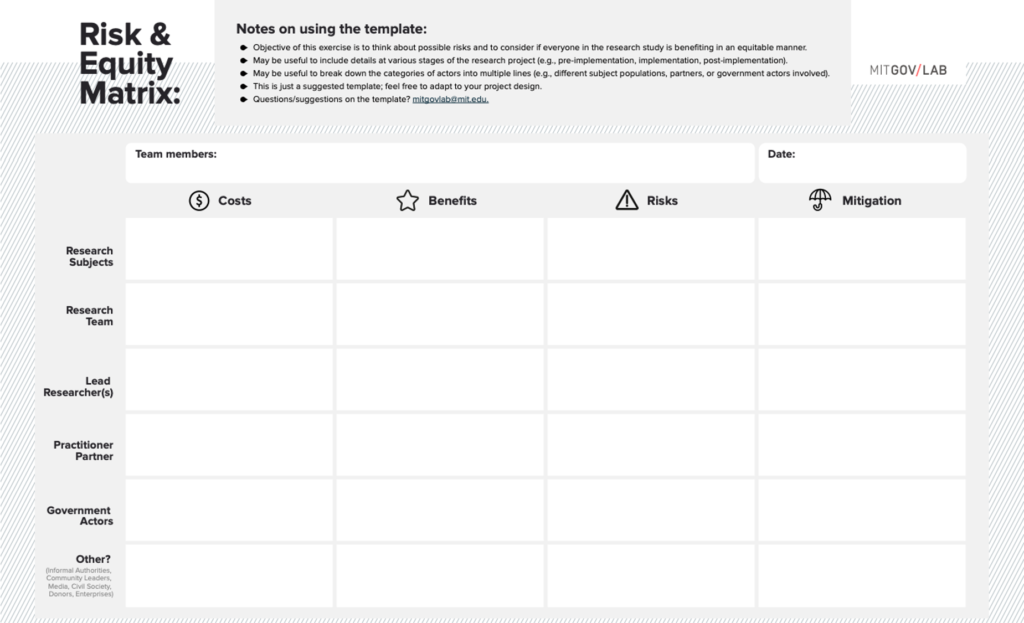Engaged Scholarship Tools
MIT GOV/LAB is developing tools to support engaged scholarship by practitioner-academic research teams. One of these tools is a Risk and Equity Matrix. The objective of the matrix is to ensure that risks and benefits of research collaborations are distributed in a more equitable manner. The purpose of this brief is to explain why the matrix exists and provide guidance on how to use it. This matrix is meant to be a living document and we welcome your feedback and experiences at mitgovlab@mit.edu.
Introduction
At the MIT Governance Lab, we practice a model of engaged scholarship, which we define as a process of rigorous research that is co-created by practitioners and grounded in local problems. We think this model results in more innovative and relevant knowledge and evidence, and ensures that both academics and practitioners benefit from the research process. Furthermore, a collaborative process makes it more likely that practitioners will use the results in their day-to-day work.
Building trust is critical to any successful and equitable academic-practitioner collaboration. But competing incentives and priorities can sometimes make these relationships challenging. That’s why we developed the Risk and Equity Matrix as a tool to help academic-practitioner research teams explicitly lay out risks and benefits for a wide range of actors involved in a research study before it begins. The Risk and Equity Matrix is meant to:
- Kickstart difficult conversations on topics that are often thought about, but not captured or discussed during the collaboration process;
- Systematically and transparently lay out imbalances and power asymmetries before research begins;
- Encourage teams to spread risk and benefits out more equitably;
- Help teams articulate and document common knowledge, build trust, and set the foundation for an open, honest working relationship
- Provides teams a benchmark or baseline to revisit and revise original decisions about the collaboration design;
- Document the collaboration process for use in research reports for partners and in annexes for pre-analysis plans;
- Help donors understand potential impacts of proposed projects and processes to make better decisions about which research projects should receive funding.
To date, we have reviewed more than fifty completed matrices, which we require as part of the applications for our internal MIT dissertation and seed funds and external grant program on building evidence on citizen engagement and government accountability. The matrix is also included as a tool in our “How to have difficult conversations”, a practical guide developed for academic-practitioner research collaborations.
Download the complete how-to guide and template to help plan and assess research collaborations in an equitable way, with new examples from research projects on Covid-19 and distance learning.


Suggested citation
MIT Governance Lab (MIT GOV/LAB). 2020. “Risk and Equity Matrix”. Version 1. Engaged Scholarship Tools. Massachusetts Institute of Technology Governance Lab (United States).
Authors: Alisa Zomer and Selmah Goldberg
Designers: Susy Tort and Gabriela Reygadas
Acknowledgements
Thank you to the practitioners and academics who helped review drafts of this document: Adam S. Levine (John Hopkins University and Research for Impact); Alison Miranda (Transparency and Accountability Initiative); Cyrus Samii (New York University, and Evidence in Governance and Politics); Fredline M’Cormack-Hale (Seton Hall University and Institute for Governance Reform); Gabrielle Kruks-Wisner (University of Virginia); Jodi Paroff (New York University); Luke Jordan (Grassroot); Katlego Mohlabane (Grassroot); Varja Lipovsek (Co-Impact); Udoi Rateng (University of Michigan); Yakama Manty Jones (Sierra Leone’s Ministry of Finance’s Research and Delivery Division).
Thanks to the entire MIT GOV/LAB team, including Faculty Director Professor Lily Tsai and Academic Director Professor Daniel Hidalgo, our graduate research fellows, and seed funding recipients for creating the original matrix template and for their feedback on various iterations of the tool. Finally, thanks to our editor Maggie Birosak for helping us translate across audiences.
